Principles of dressage
Principles of Dressage
Fine tune your understanding of dressage with this great information from the FEI.
As defined in the FEI Rule Book 2025.
© 2025 Fédération Equestre Internationale (FEI). Reproduced with the permission
of FEI. All rights reserved. Reproduction without permission is prohibited by law.
FEI is not responsible for any errors or omissions in the publication or for the
use of its Copyrighted Materials in any unauthorized manner.
- The object of dressage is the development of the horse into a happy athlete through harmonious education. As a result, it makes the horse calm, supple, loose and flexible, but also confident, attentive and keen, thus achieving perfect understanding with the rider.
- These qualities are revealed by:
- The freedom and regularity of the paces.
- The harmony, lightness and ease of the movements.
- The lightness of the forehand and the engagement of the hindquarters, originating from a lively impulsion.
- The acceptance of the bit, with submissiveness/throughness (Durchlässigkeit) without any tension or resistance.
- The horse thus gives the impression of doing, of its own accord, what is required. Confident and attentive, submitting generously to the control of the athlete, remaining absolutely straight in any movement on a straight line and bending accordingly when moving on curved lines.
- The walk is regular, free and unconstrained. The trot is free, supple, regular and active. The canter is united, light and balanced. The hindquarters are never inactive or sluggish. The horse responds to the slightest indication of the athlete and thereby gives life and spirit to all the rest of its body.
- By virtue of a lively impulsion and the suppleness of the joints, free from the paralysing effects of resistance, the horse obeys willingly and without hesitation and responds to the various aids calmly and with precision, displaying a natural and harmonious balance both physically and mentally.
- In all the work, even at the halt, the horse must be “on the bit”. A horse is said to be “on the bit” when the neck is more or less raised and arched according to the stage of training and the extension or collection of the pace, accepting the bridle with a light and consistent soft submissive contact. The head should remain in a steady position, as a rule slightly in front of the vertical, with a supple poll as the highest point of the neck, and no resistance should be offered to the athlete.
- Cadence is shown in trot and canter and is the result of the proper harmony that a horse shows when it moves with well-marked regularity, impulsion and balance. Cadence must be maintained in all the different trot or canter exercises and in all the variations of these paces.
- The regularity of the paces is fundamental to dressage.
- At the halt the horse should stand attentive, engaged, motionless, straight and square with the weight evenly distributed over all four legs. The neck should be raised with the poll as the highest point and the noseline slightly in front of the vertical. While remaining “on the bit” and maintaining a light and soft contact with the athlete’s hand, the horse may quietly chew the bit and should be ready to move off at the slightest indication of the athlete.
- The halt is obtained by the displacement of the horse’s weight to the hindquarters by a properly increased action of the seat and legs of the athlete, driving the horse towards a softly closed hand, causing an almost instantaneous but not abrupt halt at a previously fixed place. The halt is prepared by a series of half-halts (see transitions).
- The quality of the paces before and after the halt is an integral part of the assessment.
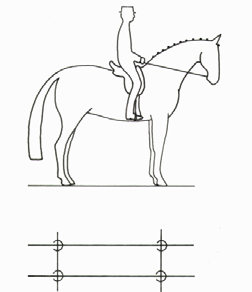
- The walk is a marching pace in a regular and well-marked four time beat with equal intervals between each beat. This regularity combined with full relaxation must be maintained throughout all walk movements.
- When the foreleg and the hind leg on the same side move almost on the same beat, the walk tends to become an almost lateral movement. This irregularity, which might become an ambling movement, is a serious deterioration of the pace.
- The following walks are recognised: Medium walk, Collected walk, Extended walk and
Free walk. There should always be a clear difference in the attitude and overtracking
in these variations.
- Medium walk. A clear, regular and unconstrained walk of moderate lengthening. The horse, remaining “on the bit”, walks energetically but relaxed with even and determined steps, the hind feet touching the ground in front of the hoof prints of the fore feet. The athlete maintains a light, soft and steady contact with the mouth, allowing the natural movement of the head and neck.
- Collected walk. The horse, remains “on the bit”, moves resolutely forward, with its neck raised and arched and showing a clear self-carriage. The head approaches the vertical position and a light contact is maintained with the mouth. The hind legs are engaged with good hock action. The pace should remain marching and vigorous, the feet being placed in regular sequence. The steps cover less ground and are higher than at the medium walk, because all the joints bend more markedly. The collected walk is shorter than the medium walk, although showing greater activity.
- Extended walk. The horse covers as much ground as possible, without
haste and without losing the regularity of the steps. The hind feet touch the ground
clearly in front of the hoof prints of the fore feet. The athlete allows the horse
to stretch out the head and neck (forward and downwards) without losing contact
with the mouth and control of the poll. The nose must be clearly in front of the
vertical.
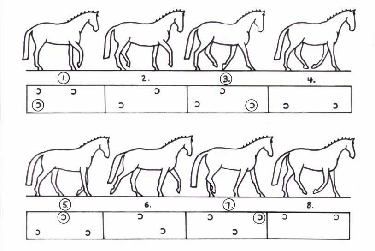
The walk is a pace in four-beat rhythm with eight phases (numbers in circles indicate the beat). - Stretching on a long rein. This exercise gives a clear impression of the "throughness" of the horse and proves the balance, suppleness, obedience and relaxation. In order to execute the exercise "stretching on a long rein" correctly, the rider must lengthen the reins as the horse stretches gradually forward and downward. As the neck stretches forwards and downwards, the mouth should reach more or less to the horizontal line corresponding with the point of the shoulder. An elastic and consistent contact with the rider's hands must be maintained. The pace must maintain its rhythm, and the horse should remain light in the shoulders with the hindlegs well engaged. During the retake of the reins the horse must accept the contact without resistance in the mouth or poll.
- The trot is a two-beat pace of alternate diagonal legs (left fore and right hind leg and vice versa) separated by a moment of suspension.
- The trot should show free, active and regular steps.
- The quality of the trot is judged by general impression, i.e. the regularity and elasticity of the steps, the cadence and impulsion in both collection and extension. This quality originates from a supple back and well-engaged hindquarters, and by the ability to maintain the same rhythm and natural balance with all variations of the trot.
- The following trots are recognised: Working trot, Lengthening of Steps, Collected
trot, Medium trot and Extended trot.
- Working trot. This is a pace between the collected and the medium trot, in which a horse’s training is not yet developed enough and ready for collected movements. The horse shows proper balance and, remaining “on the bit”, goes forward with even, elastic steps and good hock action. The expression “good hock action” underlines the importance of an impulsion originating from the activity of the hindquarters.
- Lengthening of steps. In the test for four-year-old horses "lengthening of steps" is required. This is a variation between the working and medium trot in which a horse’s training is not developed enough for medium trot.
- Collected trot. The horse, remaining “on the bit”, moves forward with the neck raised and arched. The hocks, being well-engaged and flexed, must maintain an energetic impulsion, enabling the shoulders to move with greater mobility, thus demonstrating complete self-carriage. Although the horse’s steps are shorter than in the other trots, elasticity and cadence are not lessened.
- Medium trot. This is a pace of moderate lengthening compared to the extended trot, but “rounder” than the latter. Without hurrying, the horse goes forward with clearly lengthened steps and with impulsion from the hindquarters. The athlete allows the horse to carry the head a little more in front of the vertical than at the collected and the working trot, and to lower the head and neck slightly. The steps should be even, and the whole movement balanced and unconstrained.
- Extended trot. The horse covers as much ground as possible. Without hurrying, the steps are lengthened to the utmost as a result of great impulsion from the hindquarters. The athlete allows the horse to lengthen the frame and to gain ground whilst controlling the poll. The fore feet should touch the ground on the spot towards which they are pointing. The movement of the fore and hind legs should reach equally forward in the moment of extension. The whole movement should be well-balanced and the transition to collected trot should be smoothly executed by taking more weight on the hindquarters.
- All trot work is executed “sitting”, unless otherwise indicated in the test.

The trot is a pace in two-beat rhythm with four phases (Numbers in circles indicate the beat)
- The canter is a three-beat pace where, in canter to the right, for example, the footfall is as follows: left hind, left diagonal (simultaneously left fore and right hind), right fore, followed by a moment of suspension with all four feet in the air before the next stride begins.
- The canter, always with light, cadenced and regular strides, should be moved into without hesitation.
- The quality of the canter is judged by the general impression, i.e. the regularity and lightness of the steps and the uphill tendency and cadence originating from the acceptance of the bridle with a supple poll and in the engagement of the hindquarters with an active hock action – and by the ability of maintaining the same rhythm and a natural balance, even after a transition from one canter to another. The horse should always remain straight on straight lines and correctly bent on curved lines.
- The following canters are recognised: Working canter, lengthening of strides, Collected
canter, Medium canter and Extended canter.
- Working canter. This is a pace between the collected and the medium canter, in which a horse’s training is not yet developed enough and ready for collected movements. The horse shows natural balance while remaining “on the bit”, and goes forward with even, light and active strides and good hock action. The expression “good hock action” underlines the importance of an impulsion originating from the activity of the hindquarters.
- Lengthening of strides. In the test for 4-year-old horses "lengthening of strides" is required. This is a variation between the working and medium canter in which a horse’s training is not developed enough for medium canter.
- Collected canter. The horse, remaining “on the bit”, moves forward with the neck raised and arched. The hocks, being well-engaged, maintain an energetic impulsion, enabling the shoulders to move with greater mobility thus demonstrating self carriage and an uphill tendency. The horse’s strides are shorter than in the other canters, without losing elasticity and cadence.
- Medium canter. This is a pace between the working and the extended canter. Without hurrying, the horse goes forward with clearly lengthened strides and impulsion from the hindquarters. The athlete allows the horse to 16 carry the head a little more in front of the vertical than at the collected and working canter, and at the same time allows the horse, to lower the head and neck slightly. The strides should be balanced and unconstrained.
- Extended canter. The horse covers as much ground as possible. Without hurrying, the strides are lengthened to the utmost. The horse remains calm, light and straight as a result of great impulsion from the hindquarters. The athlete allows the horse to lengthen the frame with a controlled poll and to gain ground. The whole movement should be well-balanced and the transition to collected canter should be smoothly executed by taking more weight on the hindquarters.
- Counter–canter. The counter canter is a balancing and straightening movement that must be executed in collection. The horse canters in correct sequence with the outside foreleg leading with positioning to the side of the leading leg. The foreleg should be aligned to the same track as the hind leg.
- Simple change of leg at the canter. This is a movement in which, after a direct transition out of the canter into a walk, with three to five clearly defined steps, an immediate transition is made into the other canter lead.
- Flying change of leg. The flying change is performed in one stride with the front and hind legs changing at the same moment. The change of the leading front and hind leg takes place during the moment of suspension. The aids should be precise and unobtrusive.
- Flying changes of leg can also be executed in series at every 4th, 3rd, 2nd or at every stride. The horse, even in the series, remains light, calm and straight with lively impulsion, maintaining the same rhythm and balance throughout the series concerned. In order not to restrict or restrain the lightness, fluency and groundcover of the flying changes in series, enough impulsion must be maintained.
- Aims of flying changes: To show the reaction, sensitivity and obedience of the horse to the aids for the change of leg.

The canter is a pace in three-beat rhythm with six phases
- Rein back is a rearward diagonal movement with a two-beat rhythm but without a moment of suspension. Each diagonal pair of legs is raised and returned to the ground alternatively, with the forelegs aligned on the same track as the hindlegs.
- During the entire exercise, the horse should remain “on the bit”, maintaining its desire to move forward.
- Anticipation or precipitation of the movement, resistance to or evasion of the contact, deviation of the hindquarters from the straight line, spreading or inactive hind legs and dragging forefeet are serious faults.
- The steps are counted as each foreleg moves back. After completing the required number of steps backward, the horse should show a square halt or move forward in the required pace immediately. In tests where a rein back of one horse’s length is required, it should be executed with three or four steps.
- Reinback series (Schaukel) is a combination of two rein backs with walk steps in between. It should be executed with fluent transitions and the required number of steps.
- The changes of pace and variations within the paces should be exactly performed at the prescribed marker. The cadence (except in walk) should be maintained up to the moment when the pace or movement is changed or the horse halts. The transitions within the paces must be clearly defined while maintaining the same rhythm and cadence throughout. The horse should remain light in hand, calm, and maintain a correct position.
- The same applies to transitions from one movement to another, for instance from passage to piaffe or vice versa.
- Every movement or transition should be invisibly prepared by barely perceptible half halts. The half halt is an almost simultaneous, coordinated action of the seat, the legs and the hands of the athlete, with the object of increasing the attention and balance of the horse before the execution of the movements or transitions to lower and higher paces. By shifting slightly more weight onto the horse’s hindquarters, the engagement of the hind legs and the balance on the haunches are improved for the benefit of the lightness of the forehand and the horse’s balance as a whole.
- At changes of direction, the horse should adjust the bend of his body to the curvature of the line it follows, remaining supple and following the indications of the athlete, without any resistance or change of pace, rhythm or speed.
- Changes of directions can be executed in the following ways:
-
- Right-angled turn including riding through the corner (one quarter of a volte of approx. 6 metres).
- Short and long diagonal.
- Half voltes and half circles with change of rein
- Half pirouettes and turn on the haunches.
- Serpentine loops.
- Counter-changes of hand (in zig-zag)*. The horse should be straight for a moment before changing direction.
- * zig-zag: A movement containing more than two half-passes with changes of direction.
- The figures asked in dressage tests are the voltes, the serpentines and the figures of eight.
- Volte
The volte is a circle of 6, 8 or 10 metres in diameter. If larger than 10 metres it is a circle.
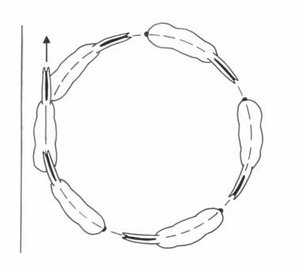
- Serpentine
The serpentine with several loops touching the long side of the arena consists of half circles connected by a straight line. When crossing the centreline, the horse should be parallel to the short side (a). Depending on the size of the half circles, the straight connection varies in length. Serpentines with one loop on the long side of the arena are executed with 5-metre or 10-metre distance from the track (b). Serpentines around the centre line are executed between the quarter lines (c).
a) 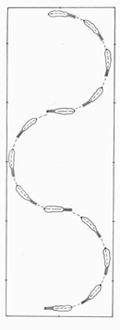
b) 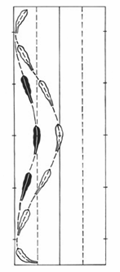
c) 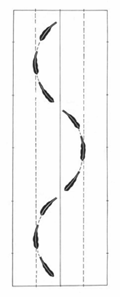
-
Figure of eight
This figure consists of two voltes or circles of equal size as prescribed in the test, joined at the centre of the eight. The athlete should make his horse straight an instant before changing direction at the centre of the figure.
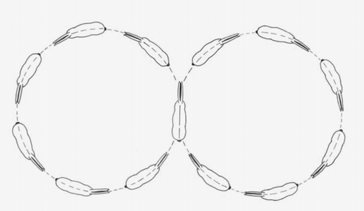
- The aim of leg yielding: To demonstrate the suppleness and lateral responsiveness of the horse.
- Leg-yielding is performed in working trot in FEI competitions. The horse is almost straight, except for a slight flexion at the poll away from the direction in which it moves, so that the athlete is just able to see the eyebrow and nostril on the inside. The inside legs pass and cross in front of the outside legs.
- Leg-yielding should be included in the training of the horse before it is ready for collected work. Later on, together with the more advanced shoulder-in movement, it is the best means of making a horse supple, loose and unconstrained for the benefit of the freedom, elasticity and regularity of its paces and the harmony, lightness and ease of its movements.
- Leg yielding can be performed “on the diagonal” in which case the horse should be as nearly as possible parallel to the long sides of the arena, although the forehand should be slightly in advance of the hindquarters. It can also be performed “along the wall” in which case the horse should be at an angle of about 35 degrees to the direction in which he is moving.
- The main aim of lateral movements – except leg-yielding - is to develop and increase the engagement of the hindquarters and thereby also the collection.
- In all lateral movements - shoulder-in, travers, renvers, and half-pass, the horse is slightly bent and moves on different tracks.
- The bend or flexion must never be exaggerated so that it does not impair the rhythm, the balance and fluency of the movement.
- In the lateral movements, the pace should remain free and regular, maintaining a constant impulsion, yet it must be supple, cadenced and balanced. The impulsion is often lost because of the athlete’s preoccupation with bending the horse and pushing it sideways.
- Shoulder-in. The shoulder-in is performed in collected trot. The horse is ridden with a slight but uniform bend around the inside leg of the athlete maintaining engagement and cadence and a constant angle of approx. 30 degrees. The horse’s inside foreleg passes and crosses in front of the outside foreleg; the inside hind leg steps forward under the horse’s body weight following the same track of the outside foreleg, with the lowering of the inside hip. The horse is bent away from the direction in which it is moving.
- Travers. Travers can be performed in collected trot or collected
canter. The horse is slightly bent round the inside leg of the athlete but with
a greater degree of bend than in shoulder-in. A constant angle of approximately
35 degrees should be shown (from the front and from behind one sees four tracks).
The forehand remains on the track and the quarters are moved inwards. The horse’s
outside legs pass and cross in front of the inside legs. The horse is bent in the
direction in which it is moving.To start the travers, the quarters must leave the track or, after a corner or circle, are not brought back onto the track. At the end of the travers, the quarters are brought back on the track (without any counter-flexion of the poll/neck) as one would finish a circle.Aims of travers: To show a fluent collected trot movement on a straight line and a correct bend. Front and hind legs are crossing, balance and cadence are maintained.
- Renvers. Renvers is the inverse movement in relation to travers.
The hindquarters remain on the track while the forehand is moved inward. To finish
the renvers the forehand is aligned with the quarters on the track. Otherwise, the
same principles and conditions that apply to the travers are applicable to the renvers.
The horse is slightly bent around the inside leg of the athlete. The horse’s outside legs pass and cross in front of the inside legs. The horse is bent in the direction in which it is moving.Aims of renvers: To show a fluent collected trot movement on a straight line with a greater degree of bend than in shoulder-in. Fore and hind legs cross, balance and cadence are maintained.
- Half pass. Half-pass is a variation of travers, executed on a diagonal
line instead of along the wall. It can be performed in collected trot (and in passage
in a freestyle) or collected canter. The horse should be slightly bent around the
inside leg of the athlete and in the direction in which it is moving. The horse
should maintain the same cadence and balance throughout the whole movement. In order
to give more freedom and mobility to the shoulders, it is of great importance that
the impulsion be maintained, especially the engagement of the inside hind leg. The
horse’s body is nearly parallel to the long side of the arena with the forehand
slightly in advance of the hindquarters.
In the trot, the outside legs pass and cross in front of the inside legs. In the canter, the movement is performed in a series of forward/sideways strides. Aims of half-pass in trot: To show a fluent collected trot movement on a diagonal line with a greater degree of bend than in shoulder-in. Fore and hind legs cross, balance and cadence are maintained.Aims of the half-pass in canter: To both demonstrate and develop the collection and suppleness of the canter by moving fluently forwards and sideways without any loss of rhythm, balance or softness and submission to the bend.
Leg yielding along the wall Leg yielding on the diagonal 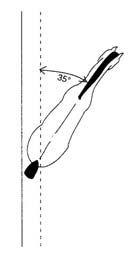
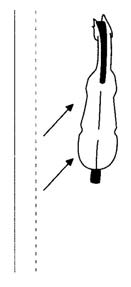
Shoulder in Travers 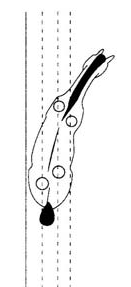

Renvers Half-pass 

- The Pirouette (half-pirouette) is a turn of 360 degrees (180 degrees) executed on two tracks, with a radius equal to the length of the horse and the forehand moving around the haunches.
- Pirouettes (half-pirouettes) are usually carried out at collected walk or canter, but can also be executed at piaffe.
- At the pirouette (half-pirouette) the forefeet and the outside hind foot move around the inside hind foot. The inside hind leg describes a circle as small as possible.
- At whatever pace the pirouette (half-pirouette) is executed, the horse, slightly bent in the direction in which it is turning, remaining “on the bit” with a light contact, turning smoothly around, and maintaining sequence and timing of footfalls of that pace. The poll remains the highest point during the entire movement.
- During the pirouettes (half-pirouettes), the horse should maintain its activity (walk also included) and never move backwards or sideways.
- In executing the pirouette or the half-pirouette in canter, the athlete should maintain
lightness of the horse while accentuating the collection. The horse’s hindquarters
are well engaged and lowered and show a good flexion of the joints. An integral
part of the movement is the quality of the canter strides before and after the pirouette.
The strides should show an increased activity and collection before the pirouette
and the balance should be maintained at the end of the pirouette.
Aims of the pirouette and half-pirouette in canter: To demonstrate the willingness of the horse to turn around the inside hind leg on a small radius, slightly bent in the direction of the turn while maintaining the activity and the clarity of the canter, the straightness and the balance before and after the figure and clear canter strides during the turn. In the pirouette or halfpirouette in canter, the judges should be able to recognize a real canter stride although the feet of the diagonal – inside hind leg, outside front leg – are not touching the ground simultaneously.Piroutte and half-pirouette in canter
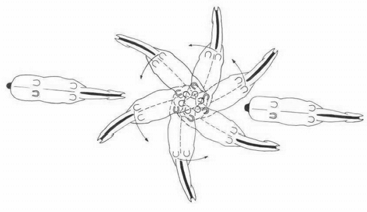
- The quality of the pirouettes (half-pirouettes) is judged according to the suppleness, lightness and regularity, and the precision and smoothness of the entrance and exit. Pirouettes (half-pirouettes) in canter should be executed in six to eight strides – full pirouettes – and three to four strides – half-pirouette.
- Half-pirouettes in walk (180 degrees) are executed out of collected walk with the
collection being maintained throughout the exercise. When the horse exits the half-pirouette
it returns to the initial track without crossing the hind legs.Half-pirouette in walk

- Turn on the haunches from walk. For younger horses that are still not able to show collected walk the “turn on the haunches” is an exercise to prepare the horse for collection. The “turn on the haunches” is executed out of medium walk prepared by half halts to shorten the steps a little and to improve the ability to bend the joints of the hindquarters. The horse does not halt before or after the turn. The “turn on the haunches” can be executed on a larger radius (approx. ½m) than the pirouette in walk, but the demands of the training scale concerning rhythm, contact, activity and straightness are the same.
- Turn on the haunches from halt to halt (180 degrees). To maintain the forward tendency of the movement one or two forward steps at the beginning of the turn are permitted. The same criteria apply as for the turn on the haunches from walk.
- Passage is a measured, very collected, elevated and cadenced trot. It is characterised by a pronounced engagement of the hindquarters, a more accentuated flexion of the knees and hocks, and the graceful elasticity of the movement. Each diagonal pair of legs is raised and returned to the ground alternately, with cadence and a prolonged suspension.
- In principle, the height of the toe of the raised forefoot should be level with the middle of the cannon bone of the other supporting foreleg. The toe of the raised hind foot should be slightly above the fetlock joint of the other supporting hind leg.
- The neck should be raised and gracefully arched with the poll as the highest point and the nose line close to the vertical. The horse should remain light, and soft “on the bit” without altering the cadence. The impulsion remains lively and pronounced.
- Irregular steps with the hind or front legs, swinging the forehand or the hindquarters
from one side to the other, as well as jerky movements of the forelegs or the hind
legs, dragging the hind legs or double beat in the moment of suspension are serious
faults.
Aim of passage is: To demonstrate the highest degree of collection, cadence and suspension in the trot.
- Piaffe is a highly collected, cadenced, elevated diagonal movement
giving the impression of remaining in place. The horse’s back is supple and elastic.
The hindquarters are lowered; the haunches with active hocks are well engaged, giving
great freedom, lightness and mobility to the shoulders and forehand. Each diagonal
pair of legs is raised and returned to the ground alternately, with spring and an
even cadence.
- In principle, the height of the toe of the raised forefoot should be level with the middle of the cannon bone of the other supporting foreleg. The toe of the raised hind foot should reach just above the fetlock joint of the other supporting hind leg.
- The neck should be raised and gracefully arched, with the poll as the highest point. The horse should remain “on the bit” with a supple poll, maintaining a soft contact. The body of the horse should move in a supple, cadenced and harmonious movement.
- Piaffe must always be animated by a lively impulsion and characterised by perfect balance. While giving the impression of remaining in place, there may be a visible inclination to advance, this being displayed by the horse’s eager acceptance to move forward as soon as it is asked.
- Moving even slightly backwards, irregular or jerky steps with the hind or front
legs, no clear diagonal steps, crossing either the fore or hind legs, or swinging
either the forehand or the hindquarters from one side to the other, getting wide
behind or in front, moving too much forward or double-beat rhythm are serious faults.
Aims of piaffe are: To demonstrate the highest degree of collection while giving the impression of remaining in place.
- Impulsion is the term used to describe the transmission of an eager
and energetic, yet controlled, propulsive energy generated from the hind quarters
into the athletic movement of the horse. Its ultimate expression can be shown only
through the horse's soft and swinging back guided by a gentle contact with the athlete's
hand.
- Speed, of itself, has little to do with impulsion; the result is more often a flattening of the paces. A visible characteristic is a more pronounced articulation of the hind leg, in a continuous rather than staccato action. The hock, as the hind foot leaves the ground, should first move forward rather than being pulled upwards, but certainly not backwards. A prime ingredient of impulsion is the time the horse spends in the air rather than on the ground. Impulsion is, therefore, seen only in those paces that have a period of suspension.
- Impulsion is a precondition for a good collection in trot and canter. If there is no impulsion, then there is nothing to collect.
- Submission does not mean subordination, but an obedience revealing
its presence by a constant attention, willingness and confidence in the whole behaviour
of the horse as well as by the harmony, lightness and ease it is displaying in the
execution of the different movements.
The degree of the submission is also demonstrated by the way the horse accepts the bit, with a light and soft contact and a supple poll. Resistance to or evasion of the athlete’s hand, being either “above the bit” or “behind the bit” demonstrates lack of submission. The main contact with the horse’s mouth must be through the snaffle bit.- Putting out the tongue, keeping it above the bit or drawing it up altogether, as well as grinding the teeth or agitation of the tail, are mostly signs of nervousness, tension or resistance on the part of the horse and must be taken into account by the judges in their marks for every movement concerned, as well as in the collective mark for “submission”.
- The first thought when considering submission is willingness, that the horse understands what is being asked of it and is confident enough in the athlete to react to the aids without fear or tension.
- The horse’s straightness, uphill tendency and balance enable it to stay in front
of the athlete’s legs and go forward into an accepting and self-carrying contact
with the bit. This is what really produces the picture of harmony and lightness.
The fulfilling of the main requirements/movements of a Dressage test is a main criterion of submission.
- The aim of the collection of the horse is:
- a) To further develop and improve the balance and equilibrium of the horse, which has been more or less displaced by the additional weight of the athlete.
- b) To develop and increase the horse's ability to lower and engage its hindquarters for the benefit of the lightness and mobility of its forehand.
- c) To add to the “ease and carriage” of the horse and to make it more pleasurable to ride.
- Collection is developed through the use of half-halts and the use of lateral movements shoulder-in, travers, renvers and half pass.
- Collection is improved and achieved by the use of the seat and legs and containing hands to engage the hind legs. The joints bend and are supple so that the hind legs can step forward under the horse’s body.
- However, the hind legs should not be engaged so far forward under the horse, that they shorten the base of support excessively, thereby impeding the movement. In such a case, the line of the back would be lengthened and raised too much in relation to the supporting base of the legs, the stability would be impaired and the horse would have difficulty in finding a harmonious and correct balance.
- On the other hand, a horse with an over-long base of support, which is unable or unwilling to engage its hind legs forward under its body, will never achieve acceptable collection, characterised by “ease and carriage” as well as a lively impulsion originating from the activity of the hindquarters.
- The position of the head and neck of a horse at the collected paces is naturally
dependent on the stage of training and, to some degree, on its conformation. It
is distinguished by the neck being raised without restraint, forming a harmonious
curve from the withers to the poll, which is the highest point, with the nose slightly
in front of the vertical. At the moment the athlete applies his aids to obtain a
momentary and passing collecting effect, the head may become more or less vertical.
The arch of the neck is directly related to the degree of collection.
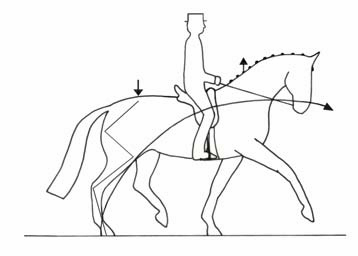
- All the movements should be obtained with imperceptible aids and without apparent effort of the athlete. The athlete should be well-balanced, elastic, sitting deep in the centre of the saddle, smoothly absorbing the movement of the horse with his loins and hips, supple thighs with the legs steady and stretched well down. The heels should be the lowest point. The upper part of the body should be tall and supple. The contact should be independent from the athlete’s seat. The hands should be carried steadily close together, with the thumb as the highest point and a straight line from the supple elbow through the hand to the horse’s mouth. The elbows should be close to the body. All of these criteria enable the athlete to follow the movements of the horse smoothly and freely.
- The effectiveness of the athlete’s aids determines the precise fulfilment of the required movements of the tests. There shall always be the impression of a harmonious co-operation between horse and athlete.
- Riding with both hands is obligatory at FEI Dressage Events. When leaving the arena at a walk on long rein, after having finished the test the athlete may, at his own discretion, ride with only one hand. For Freestyle tests, see also Directives for Judges – Freestyle tests and Directives for assessing the degree of difficulty in a Freestyle test.
- The use of the voice or clicking the tongue repeatedly is a serious fault. Refer to sanctions/penalties.
